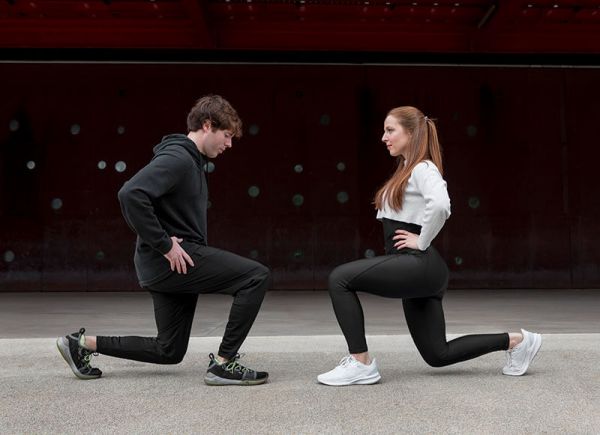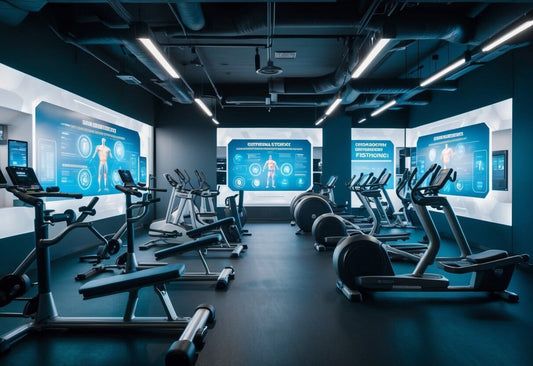
Whether you’re just starting out on your fitness journey, or looking for new ways to keep yourself on track, setting fitness goals is key. But we’re not talking about any old goals! Setting realistic fitness goals can help to keep us motivated, especially when we begin to see visible differences as a result of our workout efforts. Here we’ll be talking all about the importance of setting fitness goals, what constitutes a ‘realistic’ fitness goal and how to set fitness goals you can absolutely SMASH! But how do you go about setting workout goals? Here’s how!
Why setting fitness goals is important
 When we set ourselves fitness goals, we hold ourselves accountable, helping us go above and beyond those goals and encouraging ourselves to push just that little bit further. When it comes to setting fitness goals, you need to create realistic fitness goals that make you excited to set the next set! It’s all about identifying what you want to achieve or want to improve, and carving out the path for success. Plus, fitness goals are a great way to track your progress. After all, if you don’t know where you started and what you have achieved along the way, how will you really know how well you’ve done? Let’s take a look at how to set your fitness goals and get yourself on the route to success!
When we set ourselves fitness goals, we hold ourselves accountable, helping us go above and beyond those goals and encouraging ourselves to push just that little bit further. When it comes to setting fitness goals, you need to create realistic fitness goals that make you excited to set the next set! It’s all about identifying what you want to achieve or want to improve, and carving out the path for success. Plus, fitness goals are a great way to track your progress. After all, if you don’t know where you started and what you have achieved along the way, how will you really know how well you’ve done? Let’s take a look at how to set your fitness goals and get yourself on the route to success!
How to set fitness goals
The way in which you set your fitness goals is crucial for your future achievements. Sure, we can start off at the real basics with a goal of: Go to the gym. But what does that even measure? Nothing. So instead, let’s start off knowing that you’re already crushing your workouts and following a healthy lifestyle - you just need some realistic fitness goals along the way! So, how do you set fitness goals? Firstly, to set fitness goals that work effectively, you need to follow the SMART rule.
S - SpecificM - MeasurableA - AchievableR - RelevantT - TimelyBut what does that really mean? Let’s break down the SMART rule even further.
Setting realistic fitness goals that are: Specific The more specific you can get the better! Working towards vague fitness goals won’t help you when it comes to tracking your progress and smashing past your goal and beyond. Don’t simply say: I want to gain more strength in my arms. Or: “I want to get fit” Do think: I want to be able to lift X weight. Or: Run 5km without stopping. Writing effective, realistic fitness goals isn’t about vague ideas! When you set a specific goal, whether it’s to run for 10 minutes without stopping, lifting X amount of weight or doing X many squats - it’s much easier to know when you have reached it. Planning your personal training goals means you can start to put a strategy in place to reach them. Want to be able to run 3km in 15minutes? No problem, it’s time to get practising on that treadmill! Since you know what you want to achieve, it makes it far easier to understand the steps you need to take to reach it. Not every specific fitness goal needs to be time related, however. If you’re looking to improve your ability in a particular movement, that’s great too! Such as “I want to be able to do decline push-ups” great, let’s master the original push up and work up!
The more specific you can get the better! Working towards vague fitness goals won’t help you when it comes to tracking your progress and smashing past your goal and beyond. Don’t simply say: I want to gain more strength in my arms. Or: “I want to get fit” Do think: I want to be able to lift X weight. Or: Run 5km without stopping. Writing effective, realistic fitness goals isn’t about vague ideas! When you set a specific goal, whether it’s to run for 10 minutes without stopping, lifting X amount of weight or doing X many squats - it’s much easier to know when you have reached it. Planning your personal training goals means you can start to put a strategy in place to reach them. Want to be able to run 3km in 15minutes? No problem, it’s time to get practising on that treadmill! Since you know what you want to achieve, it makes it far easier to understand the steps you need to take to reach it. Not every specific fitness goal needs to be time related, however. If you’re looking to improve your ability in a particular movement, that’s great too! Such as “I want to be able to do decline push-ups” great, let’s master the original push up and work up!
Tracking your goals is super important for getting fit and getting into shape! Whether you’re looking to bulk up, slim down or improve your stamina, your fitness goals need to be measurable. So, how do you go about setting fitness goals you can measure? Here are some fitness goals examples you can track:
Wanting to achieve a set number of repetitions - For example, 10 push-upsRunning a personal best over a certain distanceBeing able to lift a specific weight for a certain set of repsAs well as helping you track the progress of your fitness goals, measurable goals are far easier to work towards. For example, when completing 10 push-ups, you know when you’ve hit that goal and can either set further milestones or look back on this initial goal to track your overall progress.
Realistic fitness goals: Achievable While your fitness goals should naturally be challenging, you also need to ensure you’re setting realistic fitness goals that you can achieve.
While your fitness goals should naturally be challenging, you also need to ensure you’re setting realistic fitness goals that you can achieve.
For example, setting a goal of running a marathon after a week of training is going to be pretty damn difficult to achieve. When you’re setting workout goals, try to break down your bigger, overall goals into small bite-sized goals. Of course, they may all lead to you achieving a huge goal further down the line, but for now, it’s all about achieving those small fitness goals on the way. Before setting your fitness goals, consider your fitness levels. If you’re a total beginner, achieving 20 decline push-ups in a matter of days is probably not going to be achievable.
Making your fitness goals relevantTaking your lifestyle, fitness level and resources into account, your fitness goals need to be relevant to you. Think about how your fitness comes into your lifestyle, ensuring that when you’re setting fitness goals that you have the ability to reach them. If your goals require months of hard work in the gym but you can only dedicate 1 to 2 times a month, your fitness goals are going to take a lot of time. When it feels like reaching your fitness goals takes forever, it’s easy to lose motivation. This is why you need to get specific when setting realistic fitness goals that work within your lifestyle - and even your budget. If working out several times a week just isn’t plausible, you may need to review your goals in order to set more achievable targets. Take some time to think about what achieving your specific fitness goals means to you. Will they improve your quality of life? Keep your fitness goals high, realistic but also relevant to your lifestyle and starting fitness level.
Setting workout goals that are timelyWhen setting realistic fitness goals, you need to make them time-specific. If you don’t, it can be even trickier to track your fitness improvements. Think about it, if your aim is to do 20 push-ups, but you don’t set the timeframe to achieve this goal - how are you going to create a strategy to smash it? Think: “I want to be able to do 20 push-ups by
” Setting a goal within a realistic time frame makes planning the time towards it far easier.Our top tips for setting realistic fitness goals
 Make your goals your own It’s easy to fall into the trap of checking out every fitness influencer on Instagram and setting fitness goals based on their successes. While it’s awesome to feel inspired by personal training goals and other content on social media, it can be difficult to identify what’s relevant to you. Also Read: Your Ultimate Guide to HIIT While top athletes can run marathons or lift heavy weights frequently, those achievements didn’t come overnight. Make your fitness goals yours. Make your fitness goals SMART We’ve already covered why setting SMART fitness goals is crucial, and we cannot stress this point enough! Setting workout goals that you can measure and create a plan to achieve makes your workouts 10x easier! Focus on one goal at a time I’m being totally honest here, it can feel very tempting to go writing a huge list of fitness goals you’d love to achieve. However, one of the biggest mistakes beginners make is trying to do too much in one go. Let’s say you want to hit the gym 6 times a week, cut out all sugar and drink 8 pints of water a day - now that’s a lot to conquer. Then, when you aren’t able to hit all of those goals together, it can be very easy to slip up and feel demotivated. So, ladies and gents, keep it simple! Don’t aim too high - yet It’s great to have fitness goals you can work towards - of course, it is! But, creating attainable goals will allow you to start off with some all-important wins. When you kick off your journey on the right foot, it really helps you stay in the right frame of mind. If you set fitness goals that are wayyyy too big at the very beginning, it can feel like a long slog for your first piece of success. Review your progress regularly With any fitness goal, it’s important to track your progress. When you first start, keep an eye on your progress and if needed, review your goals. It may be that you encounter a setback, or need to push yourself a little harder to achieve your goals within your specific timeframe! Also Read: How long does it take to get fit? Or, you may need to extend that timeframe if you set your goals a little too high. Don’t fret, just reassess them accordingly and keep going! Think long term fitness goals Remember, it’s great to have some big goals to work towards! Whether you’re planning to run a marathon in 10 months time or take part in a competition, setting realistic fitness goals along the way will help you in the long run. Of course, we all want instant gratification, and that’s totally normal! But it’s important to be realistic with your goals and look at the bigger picture.
Make your goals your own It’s easy to fall into the trap of checking out every fitness influencer on Instagram and setting fitness goals based on their successes. While it’s awesome to feel inspired by personal training goals and other content on social media, it can be difficult to identify what’s relevant to you. Also Read: Your Ultimate Guide to HIIT While top athletes can run marathons or lift heavy weights frequently, those achievements didn’t come overnight. Make your fitness goals yours. Make your fitness goals SMART We’ve already covered why setting SMART fitness goals is crucial, and we cannot stress this point enough! Setting workout goals that you can measure and create a plan to achieve makes your workouts 10x easier! Focus on one goal at a time I’m being totally honest here, it can feel very tempting to go writing a huge list of fitness goals you’d love to achieve. However, one of the biggest mistakes beginners make is trying to do too much in one go. Let’s say you want to hit the gym 6 times a week, cut out all sugar and drink 8 pints of water a day - now that’s a lot to conquer. Then, when you aren’t able to hit all of those goals together, it can be very easy to slip up and feel demotivated. So, ladies and gents, keep it simple! Don’t aim too high - yet It’s great to have fitness goals you can work towards - of course, it is! But, creating attainable goals will allow you to start off with some all-important wins. When you kick off your journey on the right foot, it really helps you stay in the right frame of mind. If you set fitness goals that are wayyyy too big at the very beginning, it can feel like a long slog for your first piece of success. Review your progress regularly With any fitness goal, it’s important to track your progress. When you first start, keep an eye on your progress and if needed, review your goals. It may be that you encounter a setback, or need to push yourself a little harder to achieve your goals within your specific timeframe! Also Read: How long does it take to get fit? Or, you may need to extend that timeframe if you set your goals a little too high. Don’t fret, just reassess them accordingly and keep going! Think long term fitness goals Remember, it’s great to have some big goals to work towards! Whether you’re planning to run a marathon in 10 months time or take part in a competition, setting realistic fitness goals along the way will help you in the long run. Of course, we all want instant gratification, and that’s totally normal! But it’s important to be realistic with your goals and look at the bigger picture. Ready to set your own fitness goals?
 We’ve given you the knowledge for setting realistic fitness goals of your own and now it’s ready to smash them! But if you’re looking for an extra boost in energy and your performance in the gym, why not try BlackWolf? Our 100% natural, vegan-friendly formula fires up your workout in all the right ways, with no horrid comedown.
We’ve given you the knowledge for setting realistic fitness goals of your own and now it’s ready to smash them! But if you’re looking for an extra boost in energy and your performance in the gym, why not try BlackWolf? Our 100% natural, vegan-friendly formula fires up your workout in all the right ways, with no horrid comedown. 


